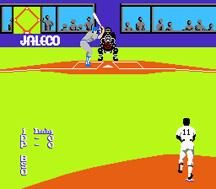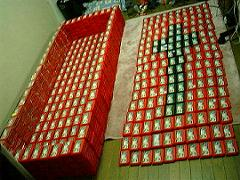
Baseball is more than just the game played on the field. It can also be the game played on the virtual field. So, Baseball Prospectus is going to write about, review, discuss, whatever the many, many baseball video games released in the last half-century that the genre has even existed.
Bases Loaded (Japan: 燃えろ!!プロ野球, or “Burn!! Pro Baseball”)
Developer: Jaleco, TOSE
Publisher: Jaleco
Platform(s): Famicom / Nintendo Entertainment System
Genre: Arcade
Release Year: 6/26/87 (JPN), September 1988 (USA)
Current Availability: 3DS Store ($4.99), Aftermarket ($3.99 + S/H), Portable Player ($24.99)
Why This Game?: If you were a kid in the 80s, you probably had an NES, and if you were a kid in the 80s who liked baseball, odds were that you probably either owned this or RBI Baseball. OK, probably the latter, but Bases Loaded was the second-most popular title of the Golden Age of the NES.
It’s hard to believe that Bases Loaded was actually only the third baseball game for the NES to reach America when it arrived in 1988, a full three years after the black-box Nintendo Baseball. Not because it closed the book on how to make a console baseball game—it very much did not—but because it feels like such a reaction to the way baseball games have been presented (and would continue to be for many years afterward, because nobody wound up following Jaleco down this path). With few exceptions, baseball video games took the perspective of an old television broadcast: high up behind the plate, the field spread out behind the pitcher.
How Does It Play?: The path in question: a mostly revolutionary camera angle that sat behind the pitcher, rather than putting the batter at the bottom of the screen, the way real baseball looked on TV. This allowed for a fully three-dimensional pitching at a time when the NES’s only attempts at 3-D required driving at a horizon and clumsily scaling sprites on a device that had no business trying either. Instead of heightless pitches that required simply timing a swing when the ball crossed the plate, pitchers could suddenly aim their deliveries—and, sadly, hitters had to aim their swings. One of these was significantly easier than the other.

We use “mostly revolutionary” because Accolade’s Hardball came out on personal computers in 1985, employing the same perspective. The difference: Rather than allowing the player to control the pitch mid-flight, Hardball asked the pitcher to select a pitch type and targeted zone. Though this decision made for less of an arcade feel, the result was more intuitive, especially for players asked to navigate three-dimensional space. To compensate for the difficulty of tracking a pitch on two axes, Jaleco shoves the pitcher to the bottom of the screen and slows down the ball in flight, which only makes reading the height of the pitch even more nightmarish. Not all revolutions are meant to succeed.
Once the ball is put into play, however, Bases Loaded reverts to the usual overhead, aim-at-the-base-and-throw gameplay that every other game has relied on. One difference, which may be what put the balance back into the imbalance pitcher/hitter matchup: rather than distort the field to make most of it visible on the screen, Jaleco opted for more realistic proportions, causing the camera to pan more and give players less time to react. When the fielder closest to the landing spot of the ball is offscreen, if the direction pad isn’t touched, he’ll automatically move toward the right spot. But it can be hard to maintain that faith on a ball hit hard into the gap.

What This Game Does Better Than The Rest: A 1988 sports video game was not going to be realistic. The ones that tried often suffered in comparison to more gameplay-oriented titles. But compared to the South Park bubble-man of RBI Baseball, Bases Loaded comes surprisingly close, without sacrificing too much. For as flawed as the actual gameplay is, Bases Loaded is fondly remembered, and it’s because so much of the presentation around the game is decorated with love and care. The synthesized voices of umpires calling pitches and outs was well ahead of its time, and the individualized skills of pitchers was new for American console players. From the memorable and nonsensical names of the unlicensed teams (The game’s greatest hitter is named “Paste”, and the umpires are dubbed Yuk, Dum, Boo, and Bum), to the to the ability to not only hit batters, but prompt a bench-clearing brawl with ejections: This was the kind of game that TOSE, a “ghost developer” that has anonymously developed over a thousand games via subcontract, was capable of when actually provided with sufficient time and money.
And then there are the cutscenes. When people think of the NES and cutscenes, they often start with Tecmo: Ryu Hayabusa looking at the castle in the distance as the camera pans, or Joe Montana pumping his fist after a touchdown in Tecmo Bowl. But the cutscenes of Bases Loaded actually predate both, and they’re an incredibly effective solution to a universal problem: Any movable sprite in a Nintendo game could only contain four colors and, unless extra chips were loaded onto each cartridge, could only be a certain size. Bases Loaded circumvented these issues by rendering a simple, colorful, large close-up after a home run, in which the pitcher buries his face into his glove. Bases Loaded may not be the best baseball game on the NES, but that’s probably the single best baseball moment on it.

Its Industry Impact: Limited. Bases Loaded continued to play with camera angles in an attempt to differentiate itself from the flood of NES baseball games that would follow. But its most distinctive trait, the over-the-shoulder perspective, was shunned by developers well into the 3-D era, instead pulling in closer behind the batter for a catcher’s-eye view. It wasn’t until the PS2, with the 2K franchise, that developers dared to use the camera everyone had been watching their live games with for years.
Fungo: Few games have demonstrated such a wildly opposing reputation between America and Japan as Bases Loaded, which is remembered fondly in the states but is derided as kosuge (an affectionate term for games that are utter trash) across the Pacific.
As a user named “Random Stranger” on the Something Awful forums reported, the game sold 1.3 million copies in its first day in Japan, and 1.5 million total, making it the 12th-highest selling game of all time on the Famicom, and also clearly the source of an entire nation’s regret. Despite glowing reviews, the game was released with game-breaking bugs, such as:
- any pitch following a foul would be called a strike regardless of placement
- the ability of one player on each team to bunt the ball over the fence
- the AI can get caught in a loop of substituting players out
- players with terrible stats were far superior to players with great stats
The result was a flood of second-hand copies, to the point where people scooped up every copy they could find for mere pennies, and used them to create coffins and tile their floors. One man in the early days of the internet was photographed bathing in hundreds of red cartridges.


Bases Loaded’s Wins Above Replacement: 1.6. Bases Loaded as a game is fine. Thanks to its 35-year-old attempts at cutting edge graphics, it doesn’t have quite the same amount of accessibility that you’d find in RBI Baseball or Baseball Stars, and it’s not a game that anyone is going to sit down and master today. But it does deserve its place on the podium for all-time NES baseball games, if only for the bronze. The music is quite good when adjusting for era, the sound effects are high-quality, the action is relatively breezy (although the difficulty in aiming leads to far more deep counts than your average video game would see or want). If someone sat you down with a system and two controllers, you’d enjoy it. If they gave you one controller and asked you to play the computer, you’d lose.
Thank you for reading
This is a free article. If you enjoyed it, consider subscribing to Baseball Prospectus. Subscriptions support ongoing public baseball research and analysis in an increasingly proprietary environment.
Subscribe now
We played in season mode. I threw a perfect game with Henter on Miami.